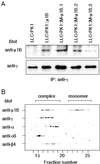Differential recognition of tyrosine-based basolateral signals by AP-1B subunit mu1B in polarized epithelial cells
- PMID: 12134076
- PMCID: PMC117320
- DOI: 10.1091/mbc.e01-10-0096
Differential recognition of tyrosine-based basolateral signals by AP-1B subunit mu1B in polarized epithelial cells
Abstract
To investigate the importance of tyrosine recognition by the AP-1B clathrin adaptor subunit mu1B for basolateral sorting of integral membrane proteins in polarized epithelial cells, we have produced and characterized a mutant form of mu1B. The mutant (M-mu1B) contains alanine substitutions of each of the four conserved residues, which in the AP-2 adaptor subunit micro2 are critical for interacting with tyrosine-based endocytosis signals. We show M-mu1B is defective for tyrosine binding in vitro, but is nevertheless incorporated into AP-1 complexes in transfected cells. Using LLC-PK1 cells expressing either wild type or M-mu1B, we find that there is inefficient basolateral expression of membrane proteins whose basolateral targeting signals share critical tyrosines with signals for endocytosis. In contrast, membrane proteins whose basolateral targeting signals are distinct from their endocytosis signals (transferrin and low-density lipoprotein receptors) accumulate at the basolateral domain normally, although in a manner that is strictly dependent on mu1B or M-mu1B expression. Our results suggest that mu1B interacts with different classes of basolateral targeting signals in distinct ways.
Figures








Similar articles
-
Basolateral sorting of human poliovirus receptor alpha involves an interaction with the mu1B subunit of the clathrin adaptor complex in polarized epithelial cells.Biochem Biophys Res Commun. 2001 Oct 5;287(4):941-8. doi: 10.1006/bbrc.2001.5660. Biochem Biophys Res Commun. 2001. PMID: 11573956
-
Sorting of H,K-ATPase beta-subunit in MDCK and LLC-PK cells is independent of mu 1B adaptin expression.Traffic. 2004 Jun;5(6):449-61. doi: 10.1111/j.1398-9219.2004.00192.x. Traffic. 2004. PMID: 15117319
-
The adaptor protein-1 μ1B subunit expands the repertoire of basolateral sorting signal recognition in epithelial cells.Dev Cell. 2013 Nov 11;27(3):353-66. doi: 10.1016/j.devcel.2013.10.006. Dev Cell. 2013. PMID: 24229647 Free PMC article.
-
The building blocks for basolateral vesicles in polarized epithelial cells.Trends Cell Biol. 2005 Apr;15(4):222-8. doi: 10.1016/j.tcb.2005.02.006. Trends Cell Biol. 2005. PMID: 15817379 Review.
-
Catch the mu1B train to the basolateral surface.Cell. 1999 Oct 15;99(2):121-2. doi: 10.1016/s0092-8674(00)81643-8. Cell. 1999. PMID: 10535730 Review. No abstract available.
Cited by
-
Role of membrane traffic in the generation of epithelial cell asymmetry.Nat Cell Biol. 2012 Dec;14(12):1235-43. doi: 10.1038/ncb2635. Nat Cell Biol. 2012. PMID: 23196841 Free PMC article. Review.
-
The clathrin adaptor AP-1A mediates basolateral polarity.Dev Cell. 2012 Apr 17;22(4):811-23. doi: 10.1016/j.devcel.2012.02.004. Dev Cell. 2012. PMID: 22516199 Free PMC article.
-
Clathrin and AP1B: key roles in basolateral trafficking through trans-endosomal routes.FEBS Lett. 2009 Dec 3;583(23):3784-95. doi: 10.1016/j.febslet.2009.10.050. Epub 2009 Oct 23. FEBS Lett. 2009. PMID: 19854182 Free PMC article. Review.
-
Polarized traffic of LRP1 involves AP1B and SNX17 operating on Y-dependent sorting motifs in different pathways.Mol Biol Cell. 2009 Jan;20(1):481-97. doi: 10.1091/mbc.e08-08-0805. Epub 2008 Nov 12. Mol Biol Cell. 2009. PMID: 19005208 Free PMC article.
-
Sorting of Pmel17 to melanosomes through the plasma membrane by AP1 and AP2: evidence for the polarized nature of melanocytes.J Cell Sci. 2006 Mar 15;119(Pt 6):1080-91. doi: 10.1242/jcs.02804. Epub 2006 Feb 21. J Cell Sci. 2006. PMID: 16492709 Free PMC article.
References
-
- Aguilar RC, Boehm M, Gorshkova I, Crouch RJ, Tomita K, Saito T, Ohno H, Bonifacino JS. Signal-binding specificity of the {micro}4 subunit of the adaptor protein complex AP-4. J Biol Chem. 2001;276:13145–13152. - PubMed
-
- Aroeti B, Okhrimenko H, Reich V, Orzech E. Polarized trafficking of plasma membrane proteins: emerging roles for coats, SNAREs, GTPases and their link to the cytoskeleton. Biochim Biophys Acta. 1998;1376:57–90. - PubMed
Publication types
MeSH terms
Substances
Grants and funding
LinkOut - more resources
Full Text Sources
Research Materials

